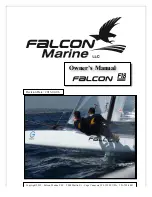
•
SMALL – chips, scratching. This type of damage is not boat threatening, but
polyester resin will absorb water over time and therefore the damaged area
should be covered with a waterproof tape until the damage is fixed. The
owner can repair this type of damage using the correct RS gel coat.
As with any modern sailing dinghy, the loads on blocks and ropes can be quite large.
As part of your rigging and de-rigging each day you should check over every part of
the boat for worn blocks and rope, twisted or bent shackle pins, and any other highly
loaded parts.
4.3 Foil Care
The foils are manufactured from anodised aluminium extrusions, with injection
moulded glass reinforced nylon ends. Lower mouldings are bonded in with
polyurethane adhesive sealant. Upper mouldings are riveted or screwed in.
Lower mouldings are sealed, however over time there may be some water ingress. If
this occurs the foils should be inverted to allow water to drain through the holes in
the top moulding.
Foils contain closed cell foam strips to ensure buoyancy at all times and limit
potential water ingress.
Maintenance:
Foils should be rinsed with fresh water after use.
Anodising will prevent surface corrosion, however if surface damage does
occur then the aluminium should be polished with a wax polish e.g. car polish.
Nylon mouldings are maintenance free but can be replaced if damaged.
If you intend to travel a lot with the boat, then an RS padded rudder bag would be a
worthwhile investment.
4.4 Spar Care
The mast, boom and bowsprit are aluminium tubing (with the exception of the top
mast which is a composite section). Wash with fresh water as often as possible, both
inside and out. Check all the riveted fittings and the masthead sheave on a regular
basis for any signs of corrosion or wear.
Содержание Vareo
Страница 1: ...Sail it Live it Love it RIGGING GUIDE...
Страница 25: ......














































